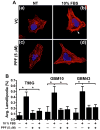Propentofylline inhibits glioblastoma cell invasion and survival by targeting the TROY signaling pathway
- PMID: 26559543
- PMCID: PMC4733619
- DOI: 10.1007/s11060-015-1981-0
Propentofylline inhibits glioblastoma cell invasion and survival by targeting the TROY signaling pathway
Abstract
Glioblastoma (GBM) is the most common primary tumor of the CNS and carries a dismal prognosis. The aggressive invasion of GBM cells into the surrounding normal brain makes complete resection impossible, significantly increases resistance to the standard therapy regimen, and virtually assures tumor recurrence. Median survival for newly diagnosed GBM is 14.6 months and declines to 8 months for patients with recurrent GBM. New therapeutic strategies that target the molecular drivers of invasion are required for improved clinical outcome. We have demonstrated that TROY (TNFRSF19), a member of the TNFR super-family, plays an important role in GBM invasion and resistance. Knockdown of TROY expression inhibits GBM cell invasion, increases sensitivity to temozolomide, and prolongs survival in an intracranial xenograft model. Propentofylline (PPF), an atypical synthetic methylxanthine compound, has been extensively studied in Phase II and Phase III clinical trials for Alzheimer's disease and vascular dementia where it has demonstrated blood-brain permeability and minimal adverse side effects. Here we showed that PPF decreased GBM cell expression of TROY, inhibited glioma cell invasion, and sensitized GBM cells to TMZ. Mechanistically, PPF decreased glioma cell invasion by modulating TROY expression and downstream signaling, including AKT, NF-κB, and Rac1 activation. Thus, PPF may provide a pharmacologic approach to target TROY, inhibit cell invasion, and reduce therapeutic resistance in GBM.
Keywords: Glioblastoma; Invasion; Resistance; Survival; TROY.
Figures





Similar articles
-
PDZ-RhoGEF Is a Signaling Effector for TROY-Induced Glioblastoma Cell Invasion and Survival.Neoplasia. 2018 Oct;20(10):1045-1058. doi: 10.1016/j.neo.2018.08.008. Epub 2018 Sep 13. Neoplasia. 2018. PMID: 30219706 Free PMC article.
-
TROY signals through JAK1-STAT3 to promote glioblastoma cell migration and resistance.Neoplasia. 2020 Sep;22(9):352-364. doi: 10.1016/j.neo.2020.06.005. Epub 2020 Jul 3. Neoplasia. 2020. PMID: 32629176 Free PMC article.
-
TROY (TNFRSF19) promotes glioblastoma survival signaling and therapeutic resistance.Mol Cancer Res. 2013 Aug;11(8):865-74. doi: 10.1158/1541-7786.MCR-13-0008. Epub 2013 May 22. Mol Cancer Res. 2013. PMID: 23699535 Free PMC article.
-
Nuclear factor-κB in glioblastoma: insights into regulators and targeted therapy.Neuro Oncol. 2016 Mar;18(3):329-39. doi: 10.1093/neuonc/nov265. Epub 2015 Nov 2. Neuro Oncol. 2016. PMID: 26534766 Free PMC article. Review.
-
A Metabolic Inhibitory Cocktail for Grave Cancers: Metformin, Pioglitazone and Lithium Combination in Treatment of Pancreatic Cancer and Glioblastoma Multiforme.Biochem Genet. 2016 Oct;54(5):573-618. doi: 10.1007/s10528-016-9754-9. Epub 2016 Jul 4. Biochem Genet. 2016. PMID: 27377891 Review.
Cited by
-
Molecular and Microenvironmental Determinants of Glioma Stem-Like Cell Survival and Invasion.Front Oncol. 2017 Jun 16;7:120. doi: 10.3389/fonc.2017.00120. eCollection 2017. Front Oncol. 2017. PMID: 28670569 Free PMC article. Review.
-
A Novel Signaling Complex between TROY and EGFR Mediates Glioblastoma Cell Invasion.Mol Cancer Res. 2018 Feb;16(2):322-332. doi: 10.1158/1541-7786.MCR-17-0454. Epub 2017 Nov 8. Mol Cancer Res. 2018. PMID: 29117939 Free PMC article.
-
Developments in Blood-Brain Barrier Penetrance and Drug Repurposing for Improved Treatment of Glioblastoma.Front Oncol. 2018 Oct 23;8:462. doi: 10.3389/fonc.2018.00462. eCollection 2018. Front Oncol. 2018. PMID: 30406029 Free PMC article. Review.
-
TROY is a promising prognostic biomarker in patients with colorectal cancer.Oncol Lett. 2018 Apr;15(4):5989-5994. doi: 10.3892/ol.2018.8079. Epub 2018 Feb 16. Oncol Lett. 2018. PMID: 29556315 Free PMC article.
-
PDZ-RhoGEF Is a Signaling Effector for TROY-Induced Glioblastoma Cell Invasion and Survival.Neoplasia. 2018 Oct;20(10):1045-1058. doi: 10.1016/j.neo.2018.08.008. Epub 2018 Sep 13. Neoplasia. 2018. PMID: 30219706 Free PMC article.
References
-
- Ostrom QT, Gittleman H, Liao P, Rouse C, Chen Y, Dowling J, Wolinsky Y, Kruchko C, Barnholtz-Sloan J. CBTRUS statistical report: primary brain and central nervous system tumors diagnosed in the United States in 2007–2011. Neuro Oncol. 2014;16(Suppl 4):iv1–63. doi: 10.1093/neuonc/nou223. - DOI - PMC - PubMed
-
- Stupp R, Mason WP, van den Bent MJ, Weller M, Fisher B, Taphoorn MJ, Belanger K, Brandes AA, Marosi C, Bogdahn U, Curschmann J, Janzer RC, Ludwin SK, Gorlia T, Allgeier A, Lacombe D, Cairncross JG, Eisenhauer E, Mirimanoff RO European Organisation for R, Treatment of Cancer Brain T, Radiotherapy G, National Cancer Institute of Canada Clinical Trials G. Radiotherapy plus concomitant and adjuvant temozolomide for glioblastoma. N Engl J Med. 2005;352(10):987–996. doi: 10.1056/NEJMoa043330. - DOI - PubMed
-
- Stupp R, Hegi ME, Mason WP, van den Bent MJ, Taphoorn MJ, Janzer RC, Ludwin SK, Allgeier A, Fisher B, Belanger K, Hau P, Brandes AA, Gijtenbeek J, Marosi C, Vecht CJ, Mokhtari K, Wesseling P, Villa S, Eisenhauer E, Gorlia T, Weller M, Lacombe D, Cairncross JG, Mirimanoff RO European Organisation for R, Treatment of Cancer Brain T, Radiation Oncology G, National Cancer Institute of Canada Clinical Trials G. Effects of radiotherapy with concomitant and adjuvant temozolomide versus radiotherapy alone on survival in glioblastoma in a randomised phase III study: 5-year analysis of the EORTC-NCIC trial. Lancet Oncol. 2009;10(5):459–466. doi: 10.1016/S1470-2045(09)70025-7. - DOI - PubMed
Publication types
MeSH terms
Substances
Grants and funding
LinkOut - more resources
Full Text Sources
Other Literature Sources
Medical
Molecular Biology Databases
Research Materials

